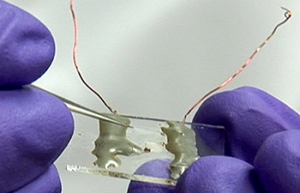The Lawrence Livermore National Laboratory, a national security laboratory, has developed a battery-less chemical detector that uses one-dimensional semiconductor nanowires.
 Battery-less chemical detector
Battery-less chemical detector
The nanosensor device does not rely on traditional batteries. It is simple and has the capability to quickly detect different molecules. The interaction that takes place between the semiconductor nanowire surfaces and the chemical species creates an electrical charge between unexposed and exposed nanowires.
The nanosensor was tested using over 15 types of solvents, including ethanol and hexane, on silicon and zinc-oxide platforms. Ethanol used in a zinc-oxide sensor led to a significant variation in electric voltage. But, the hexane solvent elicited only a small amount of voltage. This phenomenon led to the conclusion that this characteristic would enable nanosensors to distinguish various types of chemical species as well as their concentration levels.
When a silicon platform was used for similar testing, the voltage decay that took place was quite different from the zinc-oxide sensors.
The research team intends to further test the nanosensors with complex molecules from biological systems and explosives.